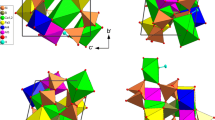Abstract
Trivalent iron is known to occur in amethysts in three different environments: substitutional with an as yet unidentified alkali ion in an adjacent interstitial site on the twofold axis (so-called S 1 center), substitutional with a proton on one of the four oxygen neighbors (S 2 center) and without detectable charge compensation (so-called I center because it was proposed to be in interstitial sites, but its nature is still disputed). The alkali ion in the S 1 center was now identified as Li and the Li and Fe superhyperfine (shf) tensors were determined by electron paramagnetic resonance at low temperatures in samples of unusually high quality. The fine structure and 1H shf structure tensors for the S 2 center with the proton on an oxygen with longer bond distance were evaluated and the geometry of the oxygen coordination was estimated by application of the superposition model. For the I center the 57Fe and 29Si shf splittings were determined and the evidence in favor of assignment to an interstitial site is reviewed.
Similar content being viewed by others
References
Barry TI, McNamara P, Moore WJ (1965) Paramagnetic resonance and optical properties of amethyst. J Chem Phys 42:2599–2606
Becker W, Lehmann G (1980) Anomalous hyperfine splitting of 57Fe in quartz. Solid State Commun 35:367–369
Behner T, Eibers G, Remme S, Prissok F, Stegger P, Lehmann G (1986) Interstitial transition metal impurities as a possible cause of enhanced reactivities. Ber Bunsenges Phys Chem 90:698–702
Cox RT (1976) ESR of an S=2 centre in amethyst and its possible identification as the d4 ion Fe4+. J Phys C 9:3355–3362
Gaite JM (1975) EPR study of Mn2+ in diopside. J Phys C 8:3887–3895
Gaite JM (1980) Pseudo-symmetries of crystallographic coordination polyhedra. Application to forsterite and comparison with some EPR results. Phys Chem Minerals 6:9–17
Heming M, Lehmann G (1987) Superposition model for the zerofield splitting of 3d ion EPR: Experimental tests, theoretical calculations and applications. In: Weil JA (Ed.), Electronic Magnetic Resonance of the Solid State. Can Soc Chem, Ottawa, p 163–174
Henning JCM, Liebertz J, van Stapele RPJ (1967) Evidence for Cr3+ in four-coordination: ESR and optical investigations of Cr-doped AlPO4 crystals. J Phys Chem Solids 28:1109–1114
Hutton DR (1964) Paramagnetic resonance of Fe+++ in amethyst and citrine quartz. Phys Lett 12:310–311
Isoya J, Weil JA (1979) Uncompensated titanium(3+) center in α-quartz. Phys Status Solidi A 52:K193–196
Krauss U, Lehmann G (1975) EPR of Fe3+ in low quartz isomorphs A(III)B(V)O4. Z Naturforsch 30a:28–34
Lehmann G (1967) Farbzentren des Eisens als Ursache der Farbe von Amethyst. Z Naturforsch 22a:2080–2086
Lehmann G (1980) Variation of hyperfine splitting constants for 3d5 ions with interatomic distance. J Phys Chem Solids 41:919–921
Lehmann G (1982) Spectroscopy of minerals. Ber Bunsenges Phys Chem 86:985–994
Lehmann G (1987) Defects in minerals. Cryst Lattice Defects 14:307–317
Lehmann G, Moore WJ (1966) Optical and paramagnetic properties of iron centers in quartz. J Chem Phys 44:1741–1745
McDonnell HM, Chestnut DB (1958) Theory of isotropic hyperfine interactions in π-electron radicals. J Chem Phys 28:107–117
Matarrese LM, Wells JS, Peterson, RL (1969) EPR spectrum of Fe3+ in synthetic brown quartz. J Chem Phys 50:2350–2360
Michoulier J, Gaite JM (1972) Site assignment of Fe3+ in low symmetry crystals. Application to NaAlSi3O8. J Chem Phys 56:5205–5213
Mombourquette MJ, Tennant WC, Weil JA (1986) EPR study of Fe3+ in α-quartz: A re-examination of the so-called I-centre. J Chem Phys 85:68–79
Mombourquette MJ, Weil JA (1985) Ab initio self-consistent-field molecular-orbital calculations on AlO4 centres in quartz. II. Can J Phys 63:1282–1293
Mombourquette MJ, Weil JA (1987) Modeling Fe3+ in quasitetrahedral surroundings using the Newman superposition model. J Chem Phys 87:3385–3391
Morton JR, Preston KF (1978) Atomic parameters for paramagnetic resonance data. J Magn Reson 30:577–582
Newman DJ, Urban W (1975) Interpretation of S-state ion EPR spectra. Adv Phys 24:793–844
Niebuhr HA (1975) Electron spin resonance of ferric ion in forsterite (Mg2SiO4). Acta Crystallogr A 31:274
Nienhaus K, Stegger P, Lehmann G, Schneider JR (1986) Assessment of quality of quartz crystals by EPR and γ-ray diffraction. J Crystal Growth 74:391–398
Nuttall RHD, Weil JA (1981) The magnetic properties of the oxygen-hole aluminium centres in crystalline SiO2. II. [AlO4/H+]+ and [AlO4/Li+]+. Can J Phys 59:1709–1718
Rubins RS, Jani SK (1977) Electron paramagnetic resonance of divalent nickel in zinc fluosilicate. J Chem Phys 66:3297–3299
Rubins RS, Hutton SL, Drumheller JE (1986) Temperature dependence of the zero-field splitting of Ni2+ in ZnSiF6·6H2O and ZnSiF6·6D2O at low temperature. J Chem Phys 84:4142–4145
Scaia CM, Hutton DR (1976) Site assignment of Fe3+ in α-quartz. Phys Status Solidi B 73:K115–117
Schirmer OF, Blazey KW, Berlinger W, Diehl R (1975) ESR and optical absorption of bound-small polarons in YAlO3. Phys Rev B 11:4201–4211
Simánek E, Müller KA (1970) Covalency and hyperfine structure constant A of iron group impurities in crystals. J Phys Chem Solids 31:1027–1040
Stegger P, Lehmann G (1989) Dynamic effects in a new substitutional center of trivalent iron in quartz. Phys Status Solidi B 151 (in print)
Zaitov MM, Zaripov MM, Samoilovich MI, Khadzhi VE, Tsinober LI (1975) Fe3+ EPR spectrum in irradiated quartz. Sov Phys Crystallogr 19:694–695
Author information
Authors and Affiliations
Rights and permissions
About this article
Cite this article
Stegger, P., Lehmann, G. The structures of three centers of trivalent iron in α-quartz. Phys Chem Minerals 16, 401–407 (1989). https://doi.org/10.1007/BF00199562
Received:
Issue Date:
DOI: https://doi.org/10.1007/BF00199562



